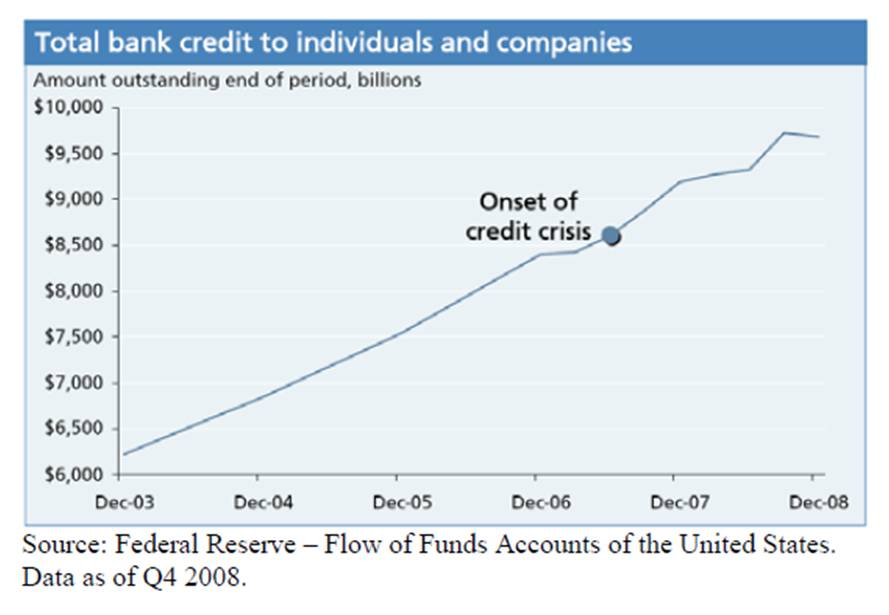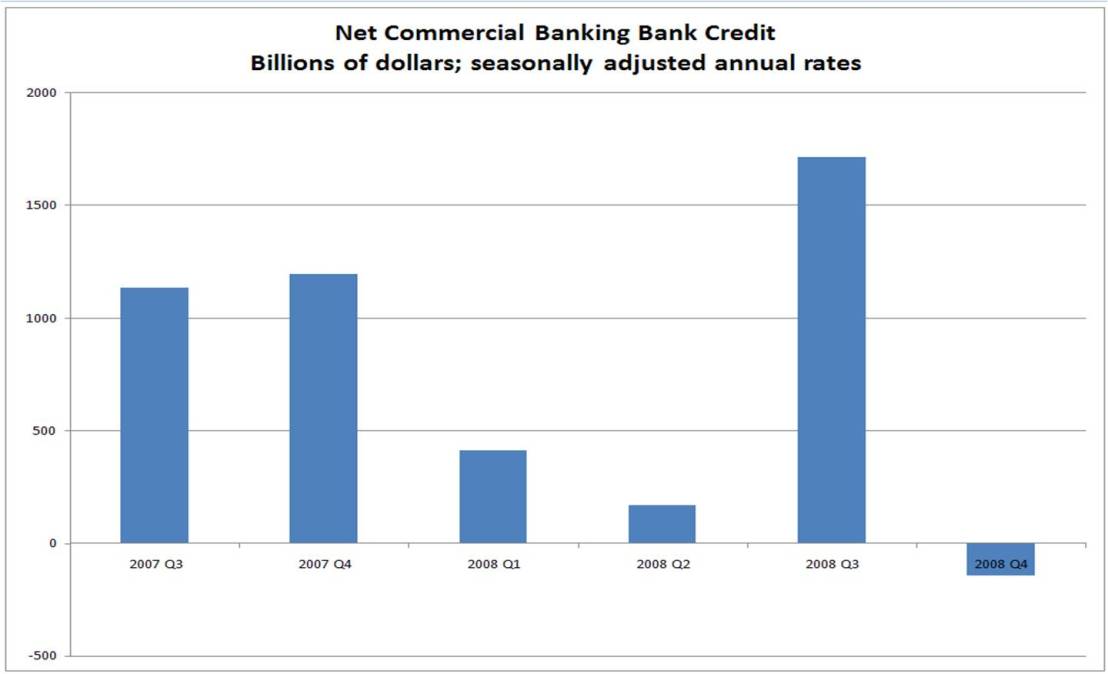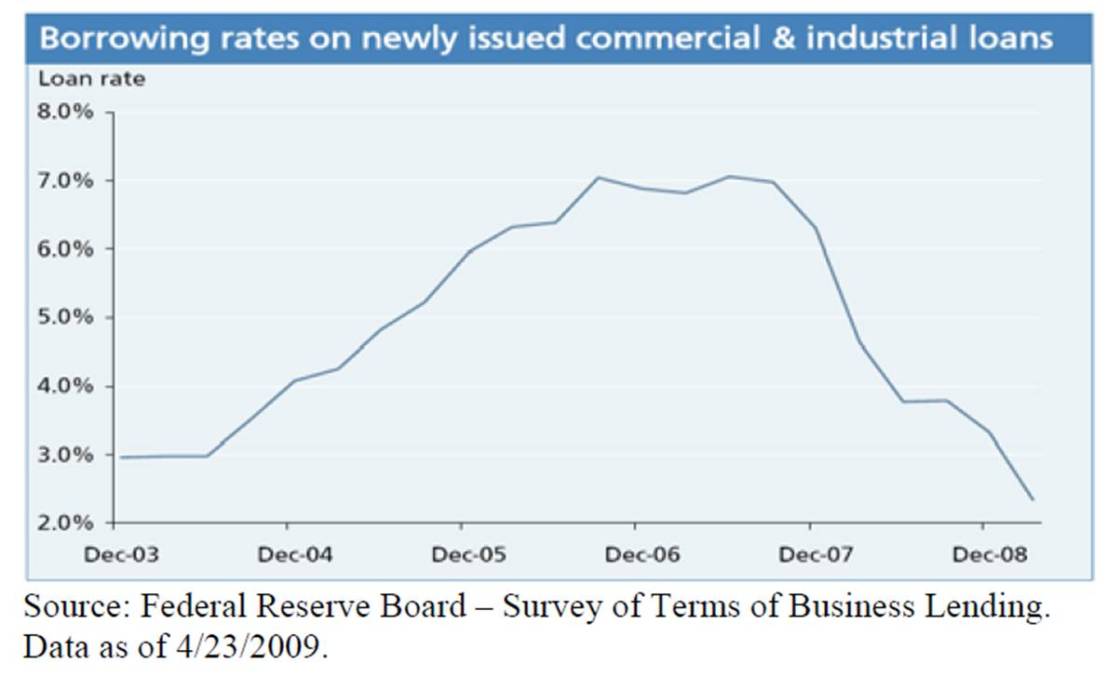JPMorgan Chase has a “community support” page entitled “The Way Forward.” It features a report by JPMorgan executive Michael Cembalest on the credit crisis called “The Big Dig,” which tries to argue that bank lending has actually increased during the credit crisis. Many more accomplished people than I have debunked this myth in the past, but I couldn’t let this pass.
Here’s the main claim: “Changes in credit are often thought to have been wrought by banks. But a simple exercise in forensics reveals that not to be the case: the rise and fall of securitized loan markets have a much larger impact. Bank lending has remained stable throughout, while securitized markets collapsed.”
Changes
in credit are often thought to have been
And here’s the evidence:
Looking at data on outstanding bank credit is misleading, because it doesn’t capture changes in bank behavior. Here’s the same data, except these are the flows rather than the levels (Table F.109 from the Flow of Funds data):
Besides the blip in Q3 2008, the picture is pretty simple: we have a steady decrease in bank lending from the beginning of 2008. So what happened in Q3?
Well, as anyone at JPMorgan should know, JPMorgan acquired the assets of Washington Mutual. Washington Mutual was technically a thrift, not a commercial bank, so its assets were not counted as commercial banking assets . . . until September 25, 2008, when they became JPMorgan’s assets. At the end of Q2, Washington Mutual had $310 billion in assets, of which the vast majority counted as bank credit. So $300 billion of the “new” bank credit in Q3 was just the result of WaMu’s collapse. Since the chart above shows annual rates, that accounts for $1.2 trillion, or over two-thirds of the total for Q3.
What else was going on in Q3? For one thing, many large banks were forced to move assets from their off-balance sheet entities onto their balance sheets, which caused one-time increases in “bank credit.” There is also $100 billion in “open market paper” ($400 billion annualized), which includes both asset-backed and regular commercial paper; this line that had a value of exactly zero in all periods back to 2004. Looking at the table for open market paper, it’s clear that everyone else (money market funds, mutual funds, etc.) was dumping open market paper, so most likely the banks (who issued a lot of the stuff during the boom) were forced to keep it on their balance sheets.
In short, the increase in bank credit in Q3 – without which Cembalest’s chart would look very different – was due to exceptional items that were a product of the credit crunch, not any actual increase in bank lending.
Nomura did a more sophisticated analysis of bank lending trends (hat tip James Hamilton), and here is their key chart:
Note the huge spike in the reported data in late 2008, which vanishes in the adjusted data.
Cembalest then makes a claim that banks are lending money at lower costs:
Here’s the same data, from the same Federal Reserve series, only showing spreads instead of nominal rates:
Note that the decline in Cembalest’s chart from late 2007 to early 2009 is completely reversed when you look at loan spreads.
So far, this is just a story about the misleading use of data. But it gets really Orwellian when Cembalest tries to blame the credit crunch on “securitized loan buyers:”
Individuals, small businesses and large corporations finding credit conditions tight are more likely impacted by the wholesale departure of securitized loan buyers than by changing bank credit conditions. There is only so much the banking sector could have done, given the collapse of another lending market that grew to be larger than itself.
Yes, you read that right. JPMorgan Chase is blaming the credit crunch on “another lending market that grew to be larger than [the banking sector].” You would think this market was created by Martians.
Here are the parties that Cembalest blames for the problems of securitization:
- Rating agencies (p. 3)
- Lazy investors (p. 3 – “investor apathy”)
- Household borrowers (pp. 3-4)
- “Non-dedicated buyers” (pp. 4-5), including enhanced income funds, securities lenders, structured investment vehicles, and broker-dealers
Nowhere does he mention that the “banks” he wants to defend were major players in enhanced income funds, securities lending, and SIVs, and the big ones, including JPMorgan, doubled as broker-dealers. More fundamentally, though, it never occurs to him that the banks who manufactured these securities – who paid mortgage lenders to drum up the borrowers, who created the models that rating agencies used to rate the securities, and who went out and sold the securities to those lazy investors – had anything to do with the credit crisis. This is free-market ideology taken to the point of nonsense: there was supply (household borrowing) and demand (hedge funds seeking yield), so we were forced to sell products that provided slightly higher yield at much higher risk. It’s the fault of the “lazy investors” for not realizing they were defective products – and it’s also their fault because they stopped buying them when they found out.
The major banks cranked out mortgage-backed and other asset-backed securities of increasing toxicity as long as they could until the bottom fell out of the market in 2008. When the crash came, they were unable to dump the securities they had in their pipelines and forced to hold onto them, causing a one-time increase in the “bank credit” on their balance sheets. As a result, they slammed the brakes on their lending, as documented in the Fed’s Survey on Bank Lending Practices. Trying to use the collapse of the securitization market as proof of the virtue of the banking sector is, as someone said of Kissinger’s Nobel Peace Prize, a bit much.
By James Kwak





In this same time frame the fed’s senior loan officer survey reported a notable spike in respondents who stated they would be lending less. Couple this with contemporaneous data from the fed’s G.19 report of contracting lending and you get the picture. Meanwhile, every banker who went on the air or made comments for attribution in print said what? “We’re lending more than ever.” So I guess it was those other bankers who were lending less …
Nice to see that someone remembers the injustice of Henry Kissinger winning the Nobel Peace Prize. At the time a wag said that “irony ended the day Henry Kissinger won the Nobel Peace Prize.” As a side note, the Vietnamese counterpart who shared the prize with Kissinger turned down the award because the United States (i.e., Kissinger) never followed through on the promises that they’d made in the original peace agreement.
Obviously, the wag of decades ago was wrong–irony is not dead. Just note the economic advisors that Obama (the “change candidate:) has working for him–Larry Summers and Tim Geithner.
And now we’re going to let these liars off the TARP hook when they assure us that JPM management has sufficient expertise and ability not to run their bank into the ground again. I’d love to see what a private equity guy would do with these preening parasites. For that matter, where’s the Red Army Faction when you need them?
This is yet another sign of JP Morgan’s amazing arrogance and adhesion to accounting trickery. There was a lot of discussion of what to do about insolvent banks, but what do we do about a bank like JPM?
This is not “annoying” bank propaganda – this is a highly crafted, well-thought-out campaign in the war on reform.
I thank you James for pointing this out. I am in the business and have wondered how the banks could say what they have been saying. I thought that it was all the refi’s: there have been alot. But that did not explain it to me.
Your article gives no room in my opinion. Either you are right or these folks are lying through their teeth. If they are then they should be held accountable and removed from their positons. Its like the difference between NAR statistics (median home prices) vs. Case Shiller analysis. The market rely on trust. This type of “information” is so dangerous to trust becasue it uses offical statistics to get people to come to agree with JPM’s conclusions. What I am trying to say is that it takes breaking the publics’ trust – to a new level….let’s call it “A New Way Forward” in trust breaking.
“For one thing, many large banks were forced to move assets from their off-balance sheet entities onto their balance sheets, which caused one-time increases in “bank credit.””
Off balance sheet entities? Forced to move assets onto their balance sheets? Pobrecitos!
Could you explain that a bit? Is there any explanation that is not fishy? Smoke and mirrors? Thanks.
In all your bank raves in print and on tv you
omit the following one point. The economy is and will
continue to shrink(not the L you predicted on tv) and therefore fewer
banks are needed to loan and hold money. In San Diego
a bank needs to be converted into
a food stamp center.
The Feds action is TO maintain the
same number of banks pre-depression.
Thank you so much for this analysis. I’m working with a client company (Sterling Pacific Financial) that is a private real estate lender, and, if there’s one thing that is completely obvious to us, it is that bank lending has been reduced to a trickle. We rely on bank refinancings of our short term/bridge loans to return our capital for reinvestment in new loans — so we know *exactly* how much longer it’s taking! In the relatively few cases in which our borrowers have refinanced, it has been painfully slow — one recent escrow took six months to close. On the plus side, we’ve got an incredible pick of deals now — but, that is still more evidence that traditional financing is still very, very scarce.
On a completely different note, one thing I didn’t see mentioned in the comments that might be relevant — doesn’t this all point back to the repeal of Glass Steagall? Isn’t this just the kind of shenanigans separating i-banking from commercial banking could prevent? I mean, if the big investment banks wanted to engage in this kind of data-spinning in the high risk/high reward world of IPOs, etc., that would be one thing — then you’re talking about presenting your “case” (however fabricated) to sophisticated players with their own armies of MBA finance whizzes on their side. But, now we have this kind of risk taking and manipulation tied up with the financial assets of virtually everyone, insured by a fund that was never meant to insure these kinds of activities … isn’t this what has emboldened them so? And how does the government ever hope to wrest control back from these entities, when they can always point a loaded gun at the economy’s head whenever they want to?
James Kwak: “You would think this market was created by Martians.” Another humorous (because it’s brutally honest and true) phrase from Mr. Kwak. It is Orwellian in every sense of the term. How do you think a bank industry whore like Cembalest got his cushy job??? Telling it like it really is???
Maybe Michael Cemblest and Joyce Chang need to hook up using the intercome and excahnge notes on how things could go belly up.
from felix salmon blog.
http://blogs.reuters.com/felix-salmon/2009/06/08/emerging-market-debt-after-ecuador/
EMTA, the erstwhile Emerging Market Traders Association, hosted an in-depth session today on the debt markets in developing countries, both sovereign and corporate. And it’s the corporate bonds which are by far the biggest worry: emerging-market corporate loans are now five times the size of the corporate bond market. And JP Morgan’s Joyce Chang came out with one of the scariest sets of datapoints I’ve come across in a while. Get this:
Total lending to emerging markets is now some $4.7 trillion.
74% of that was lent by European banks.
Both Austria and Netherlands have lent more than 50% of their GDP to foreign developing nations.
With the PPIP dying, and the Stress Tests failing, the banks better bolster their propaganda. Their Dooms Day scenario is near at hand, as the toxic assets become more deadly by the day.
Can you please elaborate why it is more accurate to look at flows than at levels? Why doesn’t outstanding bank credit capture changes in bank behavior? Thanks.
I think we won’t see every detail of the problem and that’s why we have to take what we get. I am not a friend of such attitude, but we can’t do more.
Didn’t Goldman Sachs convert to a bank in the third quarter of 2008? That would cause quite a jump in lending just by counting its existing loans.
This topic clearly exemplifies the current schizophrenic attitude towards the crisis.
On the one hand, the current predicament is blamed on the easy credit that developed over the past few years, fueled by historically low fed fund rates and related excess availability of liquidity, which was in turn compounded by deregulation and ensuing financial “innovation” and fraud.
On the other hand, the proposed cure should be to restore the pre-Lehman credit levels and -implicitly- lending practices.
It is simply absurd and if accomplished will eventually lead to something worse.
Banks, although being at the root of the crisis, cannot do anything else than to revert to sound lending standards. This inevitably means reducing the availability of credit to the system, which is part of the slow and painful deleveraging process that will eventually lead us out of the crisis.
The fact that banks purport to be lending more is the lesser of our problems, and should simply be treated as proof of the unfortunate tendency of these institutions to mislead and abhor transparency.
Would it be preferable if all banks were to take the Fannie / Freddie path, which means requiring a non-sustainable continuous taxpayer bailout for financing an anti-economic proposition?
If so, this will only lead to a renewed and even larger bubble crisis down the road.
There have been those that have been arguing this point for a long time… have a look at this post from December 2008…
http://mast-economy.blogspot.com/2008/12/no-credit-crunch-for-most-banks.html
The argument is that the top elite banks were at the nexus of the crisis… some other smaller banks were affected, but the lion-share of the 9000 US banks continued to lend at record (less vocal) rates…
James,
I appreciate the hard work you and Simon put into this sight. I would love to hear your comments regarding this article by Scott Grannis over at Calafia Beach Pundit:
http://scottgrannis.blogspot.com/2009/06/no-shortage-of-money-12.html
It seems to me the truth lies somewhere in between, especially when a person dissects the scale of each your graphs. Look forward your response.
This is totally incomprehensible. There is no way, that I, as an individual investor can hope to comprehend the complexity of the games being played. There is no place for my money except the mattress.
Good post at the level of detail, but isn’t the real question whether loans should be growing if (as I believe) there should be a delevering?